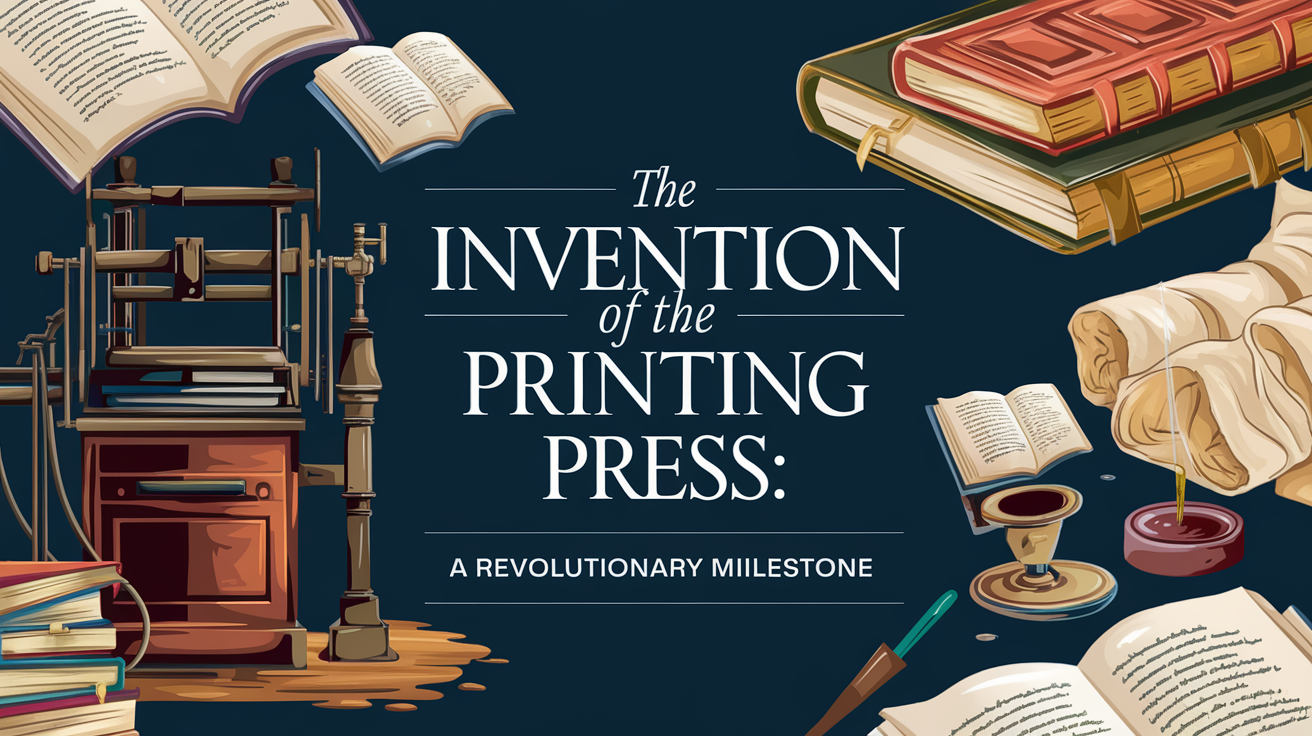The printing press stands out as one of the most significant inventions in history. This machine concentrated vast amounts of information onto paper, reproducing it in large quantities in a short time. By dismantling existing power structures, the printing press changed the world and revolutionized society. It played a crucial role in propelling Europe toward the Renaissance and ushering in the modern era. Furthermore, it made information accessible to the masses, moving away from elite exclusivity.

Historical Context and Origins
To appreciate the impact of the printing press, we must explore its origins. Although Johannes Gutenberg developed the modern printing press in Mainz, Germany, in the 1450s, earlier forms of printing appeared in ancient China and Japan. The earliest printing methods date back to the 7th century, where single-block prints created individual sheets of text. By the 10th century, movable type printing existed in China. In 14th-century Korea, a machine remarkably similar to Gutenberg’s already operated.
Interestingly, Marco Polo wrote about printing machines in the Mongol Empire, which produced bills, letters, and playing cards. Early printing techniques included Roman methods of carving images onto plaster blocks to create fabric prints, primarily for decoration rather than communication.

The Development of Printing Technology
Ink played a vital role in the printing process. By the 15th century, artisans developed oil-based ink from linseed oil and charcoal. This ink could withstand the pressure of a printing press and absorb correctly into paper without smudging. This advancement laid the groundwork for Gutenberg’s press.
Gutenberg designed a system that allowed individual movement of each letter, using molds where each letter fit perfectly with others. This innovation facilitated the standardization of parts and improved the efficiency of the printing process. Gutenberg and his partner Johann Fust established one of the first successful printing presses in Mainz, producing the Vulgate—the Latin Bible, which was in high demand and difficult to obtain in handwritten copies.
For centuries, monks meticulously copied manuscripts by hand, taking months to finish a single copy of the Bible. In contrast, Gutenberg’s press could produce 60 to 100 pages a day after setup. By 1500, printing presses had spread across major European cities, producing over 40,000 books, mostly in Italy and Germany.
The Typography Wars
This early period of printing also saw the emergence of different typographic styles. Gutenberg’s press primarily used Gothic typography, but a movement called Humanist Recovery advocated for the use of Carolingian cursive—also known as Roman type. This change aimed to reproduce classical texts from ancient Rome in a similar font, making them more accessible for readers with limited education. Thus, the first great typographic battle began—the “War of the Fonts.”

Interestingly, the use of Roman cursive type became the foundation for modern typefaces, such as Times New Roman, which we see today.
Societal Changes and the Rise of Literacy
The printing press revolutionized book production and disrupted traditional societal structures in Europe. The rise of printing guilds created professions such as librarians, booksellers, and proofreaders, requiring a population that could read and write. The printing press transformed literacy from an elite privilege into a valuable tool for business and communication.
During the 15th century, Muslim countries banned printing, believing it sinful to produce sacred texts with machinery. Sultan Selim I even outlawed printing in his territory, with death as the punishment. It wasn’t until the late 17th century that the first Turkish printing press emerged, allowing for the publication of non-religious books.
By the early 15th century, the printing press reached Russia through Tsar Peter the Great, who used it to support academies and schools, particularly in military and technological contexts. This technological spread also led to the emergence of the first newspapers, which initially served as government bulletins with minimal news about court life and occasional updates from the outside world.

The Birth of Public Opinion and Mass Culture
The advent of these bulletins fostered a growing consciousness against authority and a burgeoning sense of public opinion that had previously been nonexistent. The printing press democratized knowledge, making it accessible to a broader audience, not just clergymen and scholars.

Moreover, the printing press facilitated the distribution of pamphlets, particularly the “Bibliothèque Bleue,” which contained stories, romances, horoscopes, advice, and curious tales. These low-cost blue pamphlets captured the attention of even those who could not read, thanks to their illustrations, and became a precursor to mass culture.
The increased literacy rates led to the emergence of enlightened societies—communities capable of reading, writing, and critically analyzing complex information. This shift prompted significant societal changes, including questioning authority, much like the Protestant Reformation led by Martin Luther in the 16th century. This movement ultimately paved the way for the French Revolution and the independence of the United States.
Conclusion
The invention of the printing press revolutionized the world, fostering the rise of the first enlightened societies. It enabled the mass dissemination of ideas, prompting individuals to question authority and empowering them to analyze their world critically. The printing press not only transformed the landscape of literature but also laid the groundwork for modern democracy and the intellectual freedom we enjoy today. As you open a document and choose a font, remember that you are engaging with a typographic legacy tracing back to the very origins of the printing revolution.


